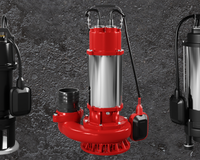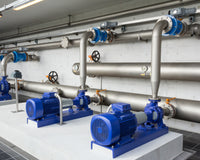Pump dry -work: causes, effects and effective security
Drywood This is one of the most common problems related to the operation of water pumping devices. It occurs when The pump works without sufficient liquid, which can lead to serious pump damage and shortening its life. In modern installations it is used Pump protection devices, such as water level sensors, water level relays or type systems SK-13which automatically turn off the pump in the event of a liquid level. Correct pump protection This is an investment that avoids costly repairs and blurring of devices.
What is a dry -work and why it is dangerous
Drywood occurs when The pump sucks water With air or there is no liquid access at all. This usually happens at too low a water mirror in a well or tank. As a result Pump operation takes place without proper cooling and lubrication, which causes overheat deep pump engine and accelerated wear of working elements. Suchób is particularly dangerous in the case of work of deep pumps, Where breaking the water mirror may lead to Depth pump blur and total damage to the rotors.
Definition and mechanism of drywall formation
Drywood It's nothing but pump work in the absence of water flow or at very low pressure. In most cases, it is caused by a decrease in water level, obstruction check valve or badly made pump assembly. In the wells where water mirror level decreases rapidly, pump installed It can pull in too high instead of liquid. The solution is Monitoring of water levels and the use of systems that allow the pump to be protected before uncontrolled interrupting the pump work. In advanced systems, even water level F&F for automatic response to changing water level.
The effects of the pump without water
The effects of pump work They are dry serious - from overheating of working elements, by burning pump engine, to the complete destruction of the rotors. In many cases, there is irreversible damage to the bearings and seals, which is associated with the need to replace the entire device. Even a short -term dry -one can lead to a decline pump life several dozen percent. That is why it is used Thermal pump protectionwhich reacts to overheating, as well as monitoring pressure switches Installation pressure and pump pressure.
Differences between the drywood and the pump overload
Although the dry -work and overload are often confused, their mechanism is completely different. Drywood this pump work in the absence of liquid, while overload occurs when The pump works with too high water pressure or with excessive flow resistance. Both phenomena are dangerous for deep pump engines And they can lead to overheating. In modern systems it is used Pump engine control and Pump operation control, which allows for immediate stopping the pump work In the event of a breakdown.
Pumps particularly vulnerable
They are most exposed deep -sea pumps, hydrophore pumps and water pumps Used in agriculture. IN in the case of deep pumps It is particularly important water mirror level and well performance. When pumps below the mirror They are not correctly set, it comes to breaking the water mirror and a dangerous decline liquid level. Good practice is level monitoring and liquid level control using electronic sensors. It is also worth using Pump engine protection and automatic systems resumption of pump work After stabilizing water state.
Deep -sea pump and the risk of lowering the water mirror
Deep pump, e.g. models IBO 3 TI, it must be installed so that its lower edge is properly Below the water mirror. With too low assembly, impurities may be sucking, and with too high - to work dry. It is worth remembering about choosing the right one pressure switch, built -in check valve and type systems SK-13which constantly monitor pump working condition. Only correct Protection of deep pumps provides safety, long pump life and stable water flow Even with a variable lifting height.
Various types of pumps that are used in home use, agriculture, as well as in many areas of industry, significantly facilitate the tasks related to pumping out water, as well as delivering it to collection points. However, in order for their action to be trouble -free, they must be well protected against dry -one and overload, which could seriously damage them. We suggest how to protect them against the risk of failure.
Why can a drywood and overload be dangerous to pumps?
Drywood It can occur both in the work of deep and immersion pumps. There can be several reasons for this - from mounting the pump too close to the water mirror, through its lowering, to the selection of too high efficiency of the device in relation to the parameters of the well. It is very dangerous, because it is generally difficult to realize that it has occurred and it may be too late to react. The pump that works dry is not able to cool the engine, as a result of which hydraulic elements may be blurred, and even to seriously damage the control unit.
Equally dangerous phenomenon is overloadwhich can bring similar effects. Its cause is usually the installation of the pump too close to the bottom. This can cause sand and silt suck, which in turn leads to faster wear of the pumping parts, and, as a consequence, to a serious overheating of the engine. As both phenomena are dangerous for the pump, it's worth knowing how to prevent them.
The best ways to protect the pump
There are several ways that can help protect the pump against dry -working and overload. These include:
- proper assembly of the pump - The pump should be installed at such a depth that the lowest, dynamic water mirror level (water mirror level determined during uninterrupted pumping at a free output) is a minimum of 2 m above the pump pressure. If the performance of the well prevents such assembly (the well is not enough in relation to the pump performance), then the valve that restricts flow constantly on the discharge pipeline can be mounted on the discharge pipeline, or the protection against the dry -one, monitoring the water mirror levels and in the event of danger
- Installation of pressure switches - it is a fairly simple solution, whose task is to control the pump work and turn off when the pressure drops,
- Installation of water level sensors - Sensors of this type are placed in the well and are designed to monitor the water mirror level. At the time of its reduction to a specific level, they turn off the pump and turn it on again when the water returns to the proper depth ceiling,
- The use of modern control devices - a comprehensive solution is to use modern pump controllers. They secure and control work of deep pumps, submersible and surface. They protect them from a drywood, a drop in tension and overload,
- use of inverter - It is a device that comprehensively controls Pump work. Its biggest advantages also include the fact that it guarantees constant pressure regardless of water intake. In turn, the elimination of pressure jumping is longer pump life and installation resulting from the lack of so -called hydraulic impact. The pump in which the inverter was used is perfectly protected against overload, low and high voltage, disappearance and asymmetry of the phase, as well as against dry -one.
In summary, there are many ways that help protect deep and submersible pumps from dry -one and overload. It is certainly worth choosing at least one of them to be sure that the pumps will work trouble -free for many years.
The most frequently asked questions (FAQ)
What is a pump dry -work and why is it dangerous?
Pump dry It is the work of a device without water or with a minimal flow. Lack of liquid means a lack of cooling and lubrication of the engine, which leads to overheating, blurring rotors and serious damage to the pump. Even a short dry -one can shorten pump life several dozen percent.
What pumps are the most vulnerable to the drywood?
They are most exposed deep -sea pumps, hydrophore pumps and water pumps used in agriculture. IN in the case of deep pumps He is decisive water mirror level and well performance. When pumps below the mirror They are incorrectly set, easy breaking the water mirror and blurring working elements.
How to protect the deep pump from dry -work?
The basis is Monitoring of water levels and the use of devices such as water level sensors Whether water level relay. It is also worth taking care of the right one pump assembly - The discharge connector should be a minimum of 2 m below the dynamic water mirror. In addition, it is helpful Thermal pump protection and type systems SK-13.
What threatens a dry -one for the pump engine?
Pump engine Without proper cooling, it overheats quickly, which can lead to sealing of bearings and seals, and even to burning windings. In extreme cases pump damage They are irreversible and require the replacement of the entire device. Therefore, it is recommended to use Pump engine protection and modern drivers.
What is the difference between dry -one and overloading the pump?
Drywood It is work without water or with a very low flow, while overload occurs when The pump works with too much flow resistance or high water pressure. Both phenomena lead to overheating deep pump engine and shorten pump life, that's why it's worth using pump control and safety sensors.
What devices protect the pump against the dry -working?
Most often it is used water level sensors, water level relays, Pressure switches and modern Pump protection devices, such as SK-13. They monitor pump working condition and automatically turn off the pump In case of reduction liquid level or breaking the water mirror.
Where to buy devices and pumps IBO ITALY?
Our products IBO ITALY you will buy on B2B platform. If you are a final customer, we encourage you to check ours partner stores and wholesalers. You can always contact us: +48 22 721 11 92, biuro@dambat.pl.
The information is educational. Before assembly, it is recommended to familiarize with the device's instructions. Dambat - IBO pump manufacturer.







